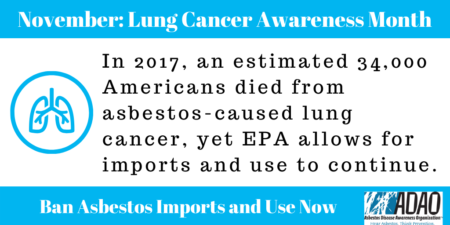Posted on October 30, 2019
 ADAO is raising asbestos awareness with each breath we take.
ADAO is raising asbestos awareness with each breath we take.
It is astounding how essential breathing is to our everyday existence, yet how little we consciously think about doing it. We get through every day thanks to the most crucial of organs in our chest cavity: our lungs.
The sad truth is that at 1.8 million deaths worldwide, lung cancer kills more people than any other form of cancer. It is responsible for roughly 1 of every 6 cancer deaths on the planet. Of the 9.6 million total deaths attributed to cancer every year, 18.4% of them are linked to lung cancer. In the United States, lung cancer kills almost two times more Americans than colon cancer and nearly four times more than breast cancer.
November 1st marked the beginning of Lung Cancer Awareness Month. This follows on the tail of Healthy Lung Month, which was celebrated in October. Though most people know that smoking can damage your lungs, many people do not know about another hazard: asbestos, a known carcinogen found in buildings, schools, cosmetics, and more. But both smoking and asbestos-exposure can increase our chances of getting fatal diseases such as lung cancer or mesothelioma. In 2017 alone, an estimated 34,000 Americans died from asbestos-caused lung cancer, yet asbestos is still being imported and used in the United States.
Many Americans still do not know that asbestos is still legal and lethal in the United States. Second-hand asbestos exposure can ripple through a community at rapid rates. The fibers of this mineral cling to the clothing and hair of people who work directly with it, making exposure possible for countless others. There is no safe level of exposure to asbestos, for either those who work directly with it, or those exposed second-hand.
Therefore, in honor of Lung Cancer Awareness Month, ADAO is presenting five ways in which you can learn more about asbestos and asbestos-related illnesses, advocate for those who have been exposed, and fight for a ban to help save lives.
- Educate oneself: Asbestos can be found in homes, schools, and workplaces. In 2018, the Chlor-alkali industry, the sole importer and user of raw chrysotile asbestos, spent $1,000,000 on purchasing the fiber from Brazil and Russia.
- Quit smoking: Acquire knowledge around smoking cessation programs. Those exposed to asbestos are 5 times more likely to get an asbestos-related respiratory disease if they smoke.
- Watch for early warning signs: A cough that won’t go away, tightness in the chest, wheezing and ongoing shortness of breath may be signs of concern. Try to seek professional medical advice if these symptoms persist.
- Aim for Early Detection: Ask your physician for a low-dose CT scan. These scans are a new and accepted form of screening tests that help improve early detection and treatment. You can learn about them in this video by Dr. Steven Markowitz.
- Learn about your diagnosis: Lung cancer develops within the lung; however, mesothelioma develops in the mesothelium. Mesothelial tumors can be non-cancerous (benign) or cancerous (malignant mesothelioma). There are four types of mesothelioma: pleural, peritoneal, pericardial and testicular. Both lung cancer and mesothelioma have a poor prognosis.
When it comes to asbestos, a catalyst of many fatal respiratory diseases, prevention is the only cure. ADAO is a proud stakeholder of the bicameral Alan Reinstein Ban Asbestos Now Act of 2019 (ARBAN) which has recently been marked up in the House of Representatives by the Subcommittee on Environment and Climate Change, and has now moved forward for consideration by the full Committee on Energy and Commerce. Once enacted, the bill would save thousands of lives by banning asbestos imports and use, without any loopholes and exemptions. The bill already has 60 cosponsors and nearly 25 national and international organizations and unions supporters. You can join this fight by signing this petition.
The time to act and save lives is now. We are stronger together.
Linda Reinstein
